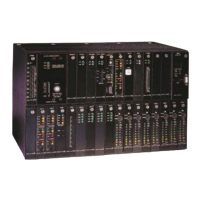Chapter 5. Diagnostics
178
Local Alarm Test
1. Break the T1 input path by placing a bantam plug in the Dual Enhanced DSX-1
Interface A IN EQ jack, or the Dual CSU Interface T1-2 EQ IN jack. The FRM LED
and the LOC LED on LIU A light. After approximately 2.5 seconds, the CGA LED
illuminates, generating a remote alarm. The FRM LED on LIU A clears. Remote
channel banks go into various alarms, depending on the alarm path configuration.
The T1 multiplexer connected to T1-2 should indicate a remote alarm. Other LEDs
will also illuminate.
2. Remove the bantam plug. All alarms should time-out and clear.
Remote Alarm Test
1. Place the bantam plug in the B OUT EQ jack on the Dual Enhanced DSX-1 Interface,
or T1-2 NET IN jack on the Dual CSU Interface. The T1 multiplexer connected to T1-
2 indicates a local alarm, and sends out a remote (yellow) alarm. The D/I Mux III
REM LED and CGA LED on LIU A lights up, indicating a remote alarm.
2. Remove the bantam plug. All alarms should time-out and clear.
Software Controlled Loopback Tests
Software controlled loopback tests require a Dual CSU Interface. The three software controlled
loopbacks that are available are remote, line, and payload.
Each software controlled loopback is available in every mode:
• Single channel bank
• Drop-and-insert
• Dual channel bank.
Remote and line loopbacks test the transmission lines from the local D/I Mux III to the far end. Payload
loopback tests some of the internal functions of the D/I Mux III.
In single channel bank operation, remote loopback from the local D/I Mux III is initiated either by entering
a Set Remote Loop-up command with the software, or by pressing the network loop push-button switch
on LIU B, which sends a network set code to the far end. The following sequence then occurs.
1. The Tx LP LED on LIU B flashes on and off for 5 seconds, then stays lit continuously.
2. The far end remains looped, and all traffic is terminated until the network loop switch on LIU B is
depressed again, or until the remote loop down command is issued, at which time a remote loop
reset code is initiated.
3. The Tx LP LED on LIU B flashes on and off for 5 seconds while the reset code is transmitted.
4. After the 5 second interval, the far end detects the reset code and then unloops. The Tx LP LED
turns off, and all traffic resumes.
Conversely, if the line loopback code is received for 5 seconds, the Rx LP LED on LIU B turns on and
the shelf goes into line loopback. The line reset code must be received for 5 seconds to unloop the
shelf. At this point, the Rx LP LED turns off.

